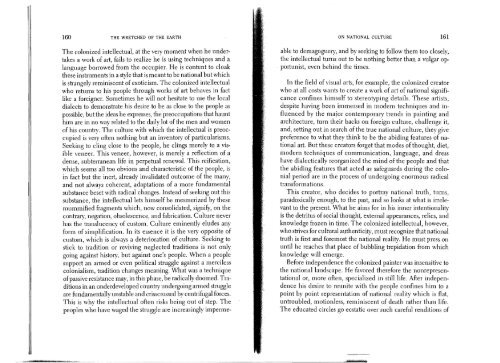wretched-of-the-earth-frantz-fanon
wretched-of-the-earth-frantz-fanon
wretched-of-the-earth-frantz-fanon
You also want an ePaper? Increase the reach of your titles
YUMPU automatically turns print PDFs into web optimized ePapers that Google loves.
160 THE WRETCHED OF THE EARTHON NATIONAL CULTURE161colonized intellectual, at <strong>the</strong> very moment when he undertakesa work <strong>of</strong> art, fails to realize he is using techniques and a'''''''F,uaF,'-' borrowed from <strong>the</strong> occupier. He is content to cloak<strong>the</strong>se instruments in a style that is meant to be national but whichis strangely reminiscent <strong>of</strong> exoticism. The colonized intellectualwho returns to his people through works <strong>of</strong> art behaveslike a foreigner. Sometimes he will not hesitate to use <strong>the</strong> localdialects to demonstrate his desire to be as close to<strong>the</strong> ideas he expresses,related to <strong>the</strong>lCllCl.:lUdl is preocaninventory <strong>of</strong> particularisms.people, he clings merely to a visveneer.1 hIS veneer, however, is merely a reflection <strong>of</strong> asubterranean life in perpetual renewal. This reification,which seems all too obvious and characteristic <strong>of</strong> <strong>the</strong> people, isin fact but inert, already invalidated outcome <strong>of</strong> <strong>the</strong> many,and not always coherent, adaptations <strong>of</strong> a more fundamentalsubstance beset with radical changes. Instead <strong>of</strong> seeking out thissubstance, <strong>the</strong> intellectual lets himself be mesmerized by <strong>the</strong>semummified fragments which, now consolidated, signify, on <strong>the</strong>contrary, negation, obsolescence, and fabrication. Culture neverhas <strong>the</strong> translucency <strong>of</strong> custom. Culture eminently anyform <strong>of</strong> simplification. In its essence it is <strong>the</strong> opposite <strong>of</strong>custom, which is always a deterioration <strong>of</strong> culture. Seeking tostick to tradition or reviving neglected traditions is notgoing against history, but against one's people. When a peoplestruggle against a mercilessmeaning. What was a technique"'''''H.d''\.,Cmay, in this phase, be radically doomed.an underdeveloped country undergoing armed struggleare fundamentally unstable and crisscrossed by centrifugal forces.This is why <strong>the</strong> intellectual <strong>of</strong>ten risks being out <strong>of</strong> step. Thepeoples who have waged <strong>the</strong> struggle are increasingly imperme-too closely,a vulgar opseeking tonothing bettertimes.In <strong>the</strong> field <strong>of</strong> visual arts, for example, <strong>the</strong> colonized creatorwho at all costs wants to create a work <strong>of</strong> art <strong>of</strong> national significanceconfines himself to stereotyping details. These artists,despite having been immersed in modern techniques and influencedby <strong>the</strong> major contemporary trends in painting andarchitecture, turn <strong>the</strong>ir backs on foreign culture, challenge it,and, setting out in search <strong>of</strong> <strong>the</strong> true national culture, <strong>the</strong>y givepreference to what <strong>the</strong>y think to be <strong>the</strong> abiding features <strong>of</strong> nationalart. But <strong>the</strong>se creators forget that modes <strong>of</strong> thought, diet,modern techniques <strong>of</strong> communication, language, andhave dialectically reorganized <strong>the</strong> mind <strong>of</strong> <strong>the</strong> people and<strong>the</strong> abiding features that as safeguardsnial period are in <strong>the</strong> process <strong>of</strong> undergoing enormoustransformations.This creator,paradoxically enough, to <strong>the</strong> past, and so looks at what isvant to <strong>the</strong> What he aims for in his inner intentionalityis <strong>the</strong> detritus <strong>of</strong>social thought, external appearances, relics, andknowledge in time. The colonized intellectual, however,for cultural au<strong>the</strong>nticity, must recognize that nationalis first and foremost <strong>the</strong> national reality. He must press onuntil he reaches that place <strong>of</strong> bubbling trepidation from whichknowledge willBefore independence <strong>the</strong> colonized painter was insensitive to<strong>the</strong> national landscape. He favored <strong>the</strong>refore <strong>the</strong> nonrepresentationalor, more <strong>of</strong>ten, specialized in still life. After independencehis desire to reunite with <strong>the</strong> people confines him to apoint by point representation <strong>of</strong> national reality which is flat,untroubled, motionless, reminiscent <strong>of</strong> death ra<strong>the</strong>rThe educated circles ecstatic over such careful


